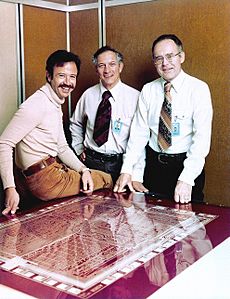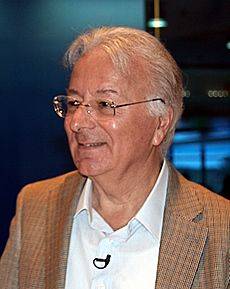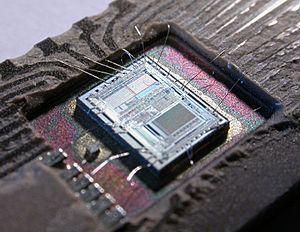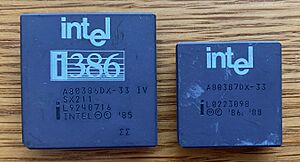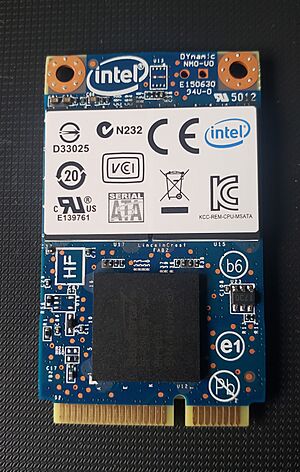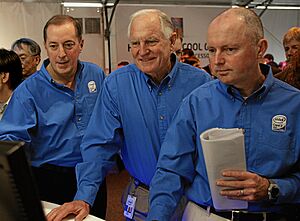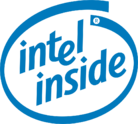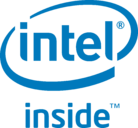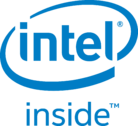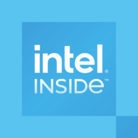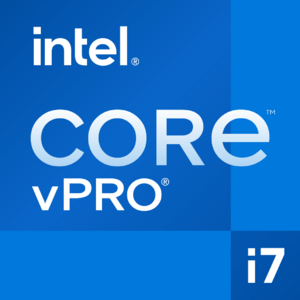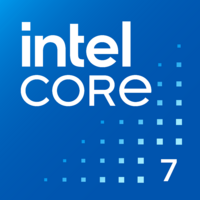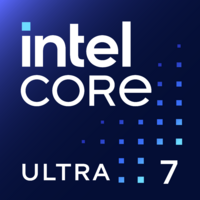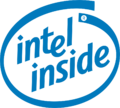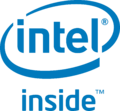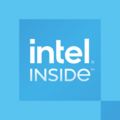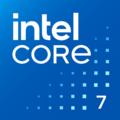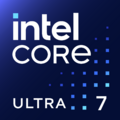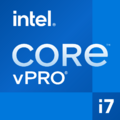Intel facts for kids

Intel logo since 2020
|
|
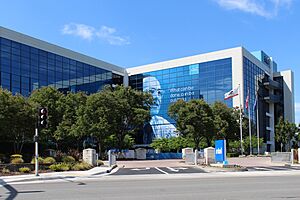
Headquarters in Santa Clara, California, in 2023
|
|
|
Trade name
|
Intel |
|---|---|
|
Formerly
|
NM Electronics/ MN Electronics (1963–1968) |
| Public | |
| Traded as | DJIA component (1999-2024) |
| Industry | Semiconductors |
| Founded | July 18, 1968 |
| Founders | |
| Headquarters |
,
U.S.
37°23′16″N 121°57′49″W / 37.38778°N 121.96361°W |
|
Area served
|
Worldwide |
|
Key people
|
|
| Revenue | |
|
Operating income
|
|
| Total assets | |
| Total equity | |
|
Number of employees
|
102,600 (2025) |
| Subsidiaries |
|
Intel Corporation is a big American technology company based in Santa Clara, California. It designs, makes, and sells computer parts like central processing units (CPUs). These are like the "brains" of computers.
Intel was the world's third-largest maker of semiconductor chips by money earned in 2024. It has been on the Fortune 500 list of the biggest U.S. companies since 2007. Intel was also one of the first companies listed on Nasdaq, a major stock market.
Intel provides microprocessors for most computer makers. It helped create the x86 series of instructions used in most personal computers (PCs). The company also makes other important parts like chipsets, flash memory, and graphics processing units (GPUs). Intel is well-known for its Intel Core CPUs, which are very fast for gaming PCs. It also makes Intel Arc GPUs.
Intel was started on July 18, 1968, by Gordon Moore and Robert Noyce, who were pioneers in making semiconductors. Arthur Rock was also an important investor. The company played a big role in making Silicon Valley a famous place for high-tech companies. Intel first focused on making memory chips like SRAM and DRAM.
Even though Intel made the world's first commercial microprocessor, the Intel 4004, in 1971, it became their main business only in the early 1990s. This was when personal computers became very popular.
In the 1990s, the teamwork between Microsoft Windows and Intel, called "Wintel", helped shape the PC world. This made Intel very strong in the market. Intel invested a lot in new microprocessor designs, helping the computer industry grow fast. During this time, Intel became the main supplier of PC microprocessors, holding 90% of the market. They were known for being very competitive. Since the 2000s, and especially after 2010, Intel has faced more competition from AMD. This has reduced Intel's market share, but they still lead the x86 market with 68.4% as of 2023.
Contents
- Intel's Journey Through Time
- Intel's Products and Market
- Intel's Business Areas
- How Intel is Organized
- Intel's Brand Identity
- Charity Work
- Sponsorships
- Product Challenges
- Images for kids
- See also
Intel's Journey Through Time
How Intel Began
Intel started in Mountain View, California, on July 18, 1968. It was founded by Gordon E. Moore, a chemist, and Robert Noyce, a physicist who helped invent the integrated circuit. Arthur Rock, an investor, also helped start the company. Moore and Noyce had previously worked at Fairchild Semiconductor.
They first named the company NM Electronics. But by the end of July, they changed it to Intel, which stands for "Integrated Electronics." The name "Intel" was already used by a hotel chain, Intelco, so they had to buy the rights to use it. Andy Grove, a chemical engineer, was Intel's third employee. He helped run the company through the 1980s and 1990s.
Early Days and First Products
When Intel started, it was good at making logic circuits using semiconductor devices. Their first goal was to make memory chips that would replace older types. In 1969, they released their first memory product, the 3101 SRAM, which was very fast. They also made the 3301 ROM and the 1101, an early MOSFET SRAM chip.
In 1970, Intel released the 1103, the first commercial dynamic random-access memory (DRAM) chip. This chip became the best-selling semiconductor memory chip in the world by 1972. Intel grew throughout the 1970s by making better manufacturing processes and more types of memory devices.
In 1971, Intel created the first commercial microprocessor, the Intel 4004. This was a huge step forward because it made the main part of a computer much smaller. This allowed small machines to do calculations that only very large computers could do before. Intel also made one of the first microcomputers in 1973.
Intel opened its first international factory in Malaysia in 1972. Later, they opened more factories and development centers in places like Singapore, Jerusalem, China, India, and Costa Rica. By the early 1980s, DRAM chips were their main business. However, competition from Japanese companies made this market less profitable.
The success of the IBM personal computer, which used an Intel microprocessor, convinced Gordon Moore (who became CEO in 1975) to focus on microprocessors. Moore decided that Intel would be the only supplier for its 386 chip, which helped the company's success.
By the late 1980s, Intel was in a great position as the main supplier of microprocessors for IBM and other PC makers. This led to 10 years of huge growth for Intel. Moore handed over his CEO role to Andy Grove in 1987. In 1991, Intel started its "Intel Inside" marketing campaign. This made their Pentium processors a household name by the end of the 1990s.
Challenges and Changes (2000s)
After 2000, the demand for very high-end microprocessors slowed down. Competitors, especially AMD, started to gain more market share. Intel's strong position in the market was reduced. In the early 2000s, then-CEO Craig Barrett tried to expand Intel's business beyond semiconductors, but most of these efforts were not very successful.
Fair Competition Challenges
Intel faced some challenges regarding fair competition. In the late 1980s and 1990s, Intel took legal action against companies that tried to make competing chips. These actions sometimes made it hard for other companies to compete.
In 2004 and 2005, AMD made claims against Intel about unfair business practices. In 2009, AMD and Intel settled their legal disputes, with Intel agreeing to pay AMD $1.25 billion. This agreement helped both companies focus on making new products.
New Focus and Success with Intel Core (2005–2015)
In 2005, CEO Paul Otellini reorganized Intel to focus on its main processor and chipset business. On June 6, 2005, Steve Jobs, who was the CEO of Apple at the time, announced that Apple would start using Intel's x86 processors for its Macintosh computers. This was a big win for Intel.
In 2006, Intel released its Core microarchitecture. This new design greatly improved processor performance and helped Intel regain its leadership. In 2008, Intel introduced the Penryn microarchitecture and later the Nehalem architecture, both of which were well-received.
In 2011, Intel started building a new microprocessor factory in Chandler, Arizona. This factory, called Fab 42, was finished in 2013 and cost $5 billion. Intel makes three-quarters of its products in the United States, even though most of its money comes from other countries.
Trying to Enter the Smartphone Market
In 2011, Intel started a project with ZTE Corporation to make smartphones using the Intel Atom processor for China. In 2011, Intel also reorganized its business units to focus on smartphones, tablets, and wireless technology. They planned to release Medfield, a processor for tablets and smartphones, in 2012 to compete with Arm. Medfield was designed to save energy, which is a key feature of Arm's chips.
Intel partnered with Google in 2011, and in 2012, Google announced that Android 2.3 would support Intel's Atom microprocessor. In 2013, Intel said they would support all major operating systems, including Linux, Android, iOS, and Chrome, not just Microsoft platforms.
In 2014, Intel reduced its workforce due to "changing market trends." They also offered to help manufacturers pay for the extra costs of using Intel chips in their tablets. In 2016, Intel stopped making chips for smartphones, leaving that market.
Intel's Custom Chipmaking
In 2013, Intel started making chips for other companies, like Altera, using its 14 nm process. This was because Intel had extra factory space. By July 2013, five companies were using Intel's factories through its Intel Custom Foundry division. However, this foundry business was closed in 2018 because Intel faced its own manufacturing challenges.
New Challenges and Growth (2016–Present)
Intel used to have a "tick-tock" model, where they would first change the chip design ("tick") and then make it smaller ("tock"). This model stopped in 2016. Intel faced difficulties making their chips smaller, from 14 nm to 10 nm. This slowed down processor development.
10 nm Process Issues
Intel originally planned to release 10 nm products in 2016, but they had manufacturing problems. The first microprocessor using this smaller size, Cannon Lake, was released in small numbers in 2018. Mass production was delayed multiple times until 2019.
Intel later admitted that their plan to shrink to 10 nm was too ambitious. Their 10 nm process was more complex than those of other companies. Because Intel's chip design and manufacturing were closely linked, processor development slowed down.
Security Concerns
In early 2018, it was reported that almost all Intel processors made since 1995 had two security flaws called Meltdown and Spectre. These flaws could potentially allow attackers to access sensitive information.
New Competition and Future Plans (2018–Present)
Because of Intel's manufacturing issues and slower processor development, the company faced strong competition. Their main competitor, AMD, released new chip designs that were very popular. AMD has grown a lot, and Intel's market share has decreased. Also, Apple started using its own chips instead of Intel processors for its Macintosh computers in 2020.
'IDM 2.0' Strategy
On March 23, 2021, CEO Pat Gelsinger announced new plans for Intel, called IDM 2.0. This plan includes investing in new factories, using both Intel's own factories and outside ones, and starting a new business called Intel Foundry Services (IFS). IFS will offer chipmaking services to other companies. Intel also partnered with IBM and confirmed that its 7 nm process was on track.
In January 2022, Intel chose New Albany, Ohio, for a new factory that will cost at least $20 billion. They expect it to start making chips by 2025. Intel also chose Magdeburg, Germany, for two new large chip factories, costing €17 billion. Construction was planned for late 2024, with production starting in 2027. These projects are expected to create many new jobs.
In August 2022, Intel partnered with Brookfield Asset Management to fund factory expansions. Intel would fund 51% of the cost of new chip-making facilities in Chandler, and Brookfield would own the remaining 49%.
In January 2023, Intel announced pay cuts for some employees and suspended bonuses to save money. These changes followed earlier job reductions in late 2022.
In October 2023, Intel confirmed it would be the first company to use a new advanced chipmaking tool called high-NA EUV lithography. This is part of its plan to become a leader in chip manufacturing again.
In December 2023, Intel showed off Gaudi3, an artificial intelligence (AI) chip for generative AI software. This chip was released in 2024 and competes with chips from Nvidia and AMD. In June 2024, Intel announced new AI chips for data centers, the Xeon 6 processor, designed to be faster and use less power. Intel's Gaudi 2 and Gaudi 3 AI accelerators were found to be more affordable than those from competitors. Intel also shared details about its Lunar Lake processors for AI PCs, which were released on September 24, 2024.
In August 2024, Intel announced plans to reduce 15,000 jobs to save $10 billion in 2025. This includes offering early retirement options. On November 1, 2024, it was announced that Intel would leave the Dow Jones Industrial Average on November 8, with Nvidia taking its place.
In July 2025, Intel confirmed it would reduce nearly 24,000 employees by the end of 2025 as part of a big restructuring plan. Intel also announced it would cancel plans for new chip factories in Europe.
Changes in Leadership
In December 2024, Intel's CEO Pat Gelsinger left his position. This happened after the company faced ongoing challenges. David Zinsner and Michelle Johnston Holthaus became interim co-CEOs. On March 13, 2025, Intel announced that Lip-Bu Tan would be their new CEO, starting March 18. Under Tan, Intel began a major restructuring to make the company smaller and focus on its main businesses. In June, they announced they would close their automotive chipmaking business and reduce staff at their Hillsboro factory. In July, it was reported that Intel would reduce 5,000 jobs across several U.S. states. They also made their AI robotics company, RealSense, a separate business. Intel's plans include reducing 24,000 jobs, canceling plans for large factories in Germany and Poland, and combining its assembly operations in Costa Rica with its sites in Vietnam.
AMD's Growth in Servers
In 2024 and 2025, AMD made big progress in the server CPU market, getting closer to Intel. As of the third quarter of 2025, Intel still held most of the server CPU market at 63.3%, with AMD at 36.5%. This shows AMD is growing, but Intel is still the main supplier.
Intel's Products and Market
Memory Chips and Microprocessors
Intel's first products were memory chips. They became a leader in making DRAM, SRAM, and ROM chips throughout the 1970s. At the same time, Intel engineers Marcian Hoff, Federico Faggin, Stanley Mazor, and Masatoshi Shima invented Intel's first microprocessor, the Intel 4004, in 1971. This chip was first made for a Japanese company called Busicom to use in a calculator. The microprocessor became Intel's main business in the mid-1980s.
In 1983, as personal computers became popular, Intel faced tough competition from Japanese memory-chip makers. Andy Grove, who was president then, decided to focus the company on microprocessors. He wrote about this change in his book Only the Paranoid Survive. A key part of his plan was to be the only supplier for the popular 8086 microprocessor and its newer versions.
Before this, making complex chips was not always reliable, so customers often wanted more than one supplier. But Grove started making processors in three different factories and stopped letting other companies, like AMD, make copies of Intel's chip designs. When the PC industry grew rapidly in the late 1980s and 1990s, Intel benefited greatly.
Early x86 Processors and the IBM PC
Even though microprocessors became very important, the 4004 and its follow-ups, the 8008 and 8080, did not bring in a lot of money for Intel at first.
In 1975, Intel started a project to create a very advanced 32-bit microprocessor, which was released in 1981 as the Intel iAPX 432. This project was too difficult, and the processor did not work as well as hoped, so it was not successful. Intel later made the x86 architecture work with 32 bits instead.
When the 8086 processor was finished in 1978, Intel started a big marketing effort called "Operation Crush." They wanted to get as many customers as possible for this chip. One important customer was the new IBM PC division, though its importance was not fully clear at the time.
IBM launched its personal computer in 1981, and it quickly became very popular. In 1982, Intel created the 80286 microprocessor, which was used in the IBM PC/AT two years later. Compaq, the first company to make IBM PC "clones," released a computer with the faster 80286 processor in 1985. In 1986, Compaq quickly followed with the first system using the 80386 processor, beating IBM. This created a competitive market for PC-compatible systems and made Intel a key supplier of computer parts.
The 386 Microprocessor
During this time, Andrew Grove changed the company's direction a lot. He closed most of Intel's DRAM business and put resources into the microprocessor business. A very important decision he made was to be the only supplier for the 386 microprocessor.
Before this, making microprocessors was new, and problems often stopped production. To avoid this, customers usually wanted multiple manufacturers to make the chips. The 8080 and 8086-series microprocessors were made by several companies, including AMD, with whom Intel had an agreement to share technology.
Grove decided not to let other companies make the 386 design. Instead, he made it in three different factories: Santa Clara, California; Hillsboro, Oregon; and Chandler, Arizona. He convinced customers that this would ensure they always got their chips. By doing this, Intel broke its contract with AMD. AMD sued and received millions of dollars, but they could no longer make new Intel CPU designs. Instead, AMD started to create its own competing x86 designs.
As the Deskpro 386 became very popular, the 386 became the main CPU choice. Intel became almost the only supplier. The money from this success helped Intel quickly develop better chip designs and manufacturing methods. This made Intel the clear leader by the early 1990s.
486, Pentium, and Itanium
Intel released the 486 microprocessor in 1989. In 1990, they created a second design team to work on processors code-named "P5" and "P6" at the same time. They aimed to release a major new processor every two years, which was much faster than before. The P5 project was also known as "Operation Bicycle."
The P5 was released in 1993 as the Intel Pentium. They used a registered trademark name instead of a number because numbers like 486 cannot be legally trademarked in the United States. This meant competitors could not just call their processors the same name. The P6 followed in 1995 as the Pentium Pro and was improved into the Pentium II in 1997. New designs were created in Santa Clara, California, and Hillsboro, Oregon.
In 1993, the Santa Clara design team started working on a new design after the x86 architecture, code-named "P7." The first attempt was stopped, but it was quickly restarted with engineers from Hewlett-Packard. Intel soon took over most of the design work. The result was the Itanium, a 64-bit chip released in June 2001. The Itanium did not perform as well as expected when running older x86 programs and struggled to compete with x86-64, which was AMD's 64-bit version of the x86 architecture. Intel later called its version Intel 64. In 2017, Intel announced that the Itanium 9700 series would be the last Itanium chips they made.
The Hillsboro team designed the Willamette processors, which were sold as the Pentium 4.
During this time, Intel had two big advertising campaigns. The first was the 1991 "Intel Inside" marketing campaign, which is very famous. The idea of "ingredient branding" (making a part of a product famous) was new then. David House, who led the microprocessor division, came up with the slogan "Intel Inside." This campaign made Intel, which was a little-known supplier, a household name.
The second campaign, Intel's Systems Group, started in the early 1990s. It showed how Intel made PC motherboards, which are the main circuit boards where the processor and memory chips are plugged in. This campaign was less known than "Intel Inside."
Soon after, Intel started making complete "white box" computer systems for many PC clone companies. At its peak in the mid-1990s, Intel made over 15% of all PCs, making it the third-largest supplier.
During the 1990s, Intel Architecture Labs (IAL) created many hardware innovations for PCs, like the PCI Bus, the PCI Express (PCIe) bus, and Universal Serial Bus (USB). IAL's software efforts were not as successful, often facing strong competition from Microsoft.
The Pentium Math Issue
In June 1994, Intel engineers found a small issue in the math part of the P5 Pentium microprocessor. In very specific situations, the result of a floating-point division could be slightly wrong. This error could get bigger in later calculations.
A math professor named Thomas Nicely discovered the issue independently in October 1994. He contacted Intel but did not get a response. He then shared his findings online, and the news spread quickly. The issue was easy to show, for example, by typing certain numbers into a calculator on a computer. Many users did not believe Intel's claim that the error was minor.
Intel later changed its mind and offered to replace every affected Pentium CPU. This cost Intel $475 million in 1994. Nicely later found out that Intel had known about the issue before him but had not told customers.
The "Pentium flaw" incident, how Intel handled it, and the media coverage made Intel, a company previously unknown to most computer users, a household name. This event, combined with the "Intel Inside" campaign, is seen as having a positive effect on Intel. It made them more focused on end-users and increased public awareness of the brand.
Intel Core Processors
The Intel Core line began with the 32-bit Yonah CPU, which was Intel's first dual-core mobile processor designed for low power. It used an improved version of the P6 design. Its next version, the Core 2 family, came out on July 27, 2006. This was a 64-bit design. Instead of just making chips faster, the Core design focused on using less power and returning to lower speeds. It also made the chip's parts work more efficiently, which reduced power use while increasing processing power.
In November 2008, Intel released the first-generation Core processors based on the Nehalem microarchitecture. Intel also started a new naming system: Core i3, i5, and i7 (and later i9). These names do not directly match specific technical features. The Westmere microarchitecture followed in 2010, making chips even smaller (32 nm) and including Intel HD Graphics.
In 2011, Intel released the second-generation Core processors based on Sandy Bridge. This generation was 11% faster than Nehalem. It was followed by the third-generation Core, based on Ivy Bridge, in 2012. Ivy Bridge chips were even smaller (22 nm) and supported new types of memory.
Intel continued its "tick-tock" model until the sixth-generation Core family, based on the Skylake design. This model was stopped in 2016. From 2016 to 2021, Intel released more versions of the Skylake design with improvements. Intel had trouble making its chips smaller, from 14 nm to 10 nm. The first chip using the 10 nm size, Cannon Lake, was only released in small numbers in 2018.
In 2019, Intel released the 10th-generation Core processors, including "Amber Lake," "Comet Lake," and "Ice Lake." Ice Lake used the 10 nm process and was for low-power mobile devices. Amber Lake and Comet Lake used a refined 14 nm process, with Comet Lake for desktops and high-performance mobile devices.
In September 2020, 11th-generation Core mobile processors, called Tiger Lake, were launched. Tiger Lake used a refined 10 nm process. Intel later released 11th-generation Core desktop processors, called "Rocket Lake", on March 30, 2021. All 11th-generation Core processors have new graphics based on the Intel Xe design.
Both desktop and mobile products started using the same manufacturing process with the 12th-generation Intel Core processors, called "Alder Lake", released in late 2021. These chips use Intel's 10 nm process (called Intel 7) and have a hybrid design with powerful "Golden Cove" cores and energy-efficient "Gracemont" (Atom) cores.
CPU Security Issues
Apple's Use of Intel Products (2005–2019)
On June 6, 2005, Steve Jobs, then CEO of Apple, announced that Apple would switch its Macintosh computers from PowerPC processors to Intel's x86 processors. This was a big deal for Intel. The first Mac computers with Intel CPUs were announced on January 10, 2006. By August 2006, all of Apple's consumer Macs used Intel processors.
Even though Apple used Intel products, their relationship was sometimes difficult. Rumors of Apple making its own processors started as early as 2011. On June 22, 2020, Tim Cook, Apple's CEO, announced that Apple would switch its entire Mac line from Intel CPUs to custom Apple-designed processors over the next two years. This change was not expected to affect Intel much at first, as Apple only made up a small part of its income. However, it made other PC makers think about their reliance on Intel. By November 2020, Apple revealed the M1, its own processor designed for the Mac.
Solid-State Drives (SSDs)
In 2008, Intel started selling solid-state drives (SSDs) with up to 160 GB of storage. Like their CPUs, Intel makes SSD chips using smaller and smaller processes. These SSDs use common industry standards like NAND flash, mSATA, PCIe, and NVMe. In 2017, Intel introduced SSDs using 3D XPoint technology under the Optane brand.
In 2021, SK Hynix bought most of Intel's NAND memory business for $7 billion. Intel also stopped making consumer Optane products in 2021. In July 2022, Intel announced it would stop developing its Optane business, which meant stopping the development of 3D XPoint technology.
Supercomputers
The Intel Scientific Computers division was started in 1984 to design and build parallel computers using Intel microprocessors. In 1992, it became the Intel Supercomputing Systems Division. This division designed several supercomputer systems, including the Intel iPSC/1, iPSC/2, iPSC/860, Paragon, and ASCI Red. In November 2014, Intel said it planned to use optical fibers to improve networking within supercomputers.
Fog Computing
On November 19, 2015, Intel, along with Arm, Dell, Cisco Systems, Microsoft, and Princeton University, created the OpenFog Consortium. This group works to promote and develop fog computing, which is a way to process data closer to where it's created.
Self-Driving Cars
Intel is a major player in the self-driving car industry. They joined this area in mid-2017 after teaming up with Mobileye. Intel is also one of the first companies in this field to study how people feel about self-driving technology. An AAA report found that 78% of people in the U.S. did not accept the technology.
Key topics of discussion were the safety levels of autonomous driving, giving up control to a machine, and how comfortable passengers feel. People also said they did not want to see everything the car was doing, especially the steering wheel moving by itself with no one driving. Intel learned that voice control is important, and a good interface between humans and the machine helps people feel more comfortable and in control.
Programmable Devices
After buying Altera, Intel created a new business unit called the Programmable Solutions Group (PSG). Intel has since sold Stratix, Arria, and Cyclone FPGAs (special chips that can be programmed). In 2019, Intel released Agilex FPGAs, which are chips for data centers, 5G applications, and other uses.
In October 2023, Intel announced it would make PSG a separate company in early 2024. Intel will still own most of it.
By the late 1990s, microprocessors had become more powerful than what most software needed. This meant that after 2000, consumers could use cheaper computers effectively.
Intel's strategy was to release new, better processors very quickly. For example, the Pentium II came out in May 1997, the Pentium III in February 1999, and the Pentium 4 in late 2000. This strategy became less effective because consumers did not see the new innovations as essential. This gave competitors, especially AMD, a chance to gain market share. This also reduced the profitability of Intel's processor line and ended a time when Intel completely dominated PC hardware.
Intel's strong position in the x86 microprocessor market led to many claims of unfair business practices over the years. This included investigations by the Federal Trade Commission and lawsuits from other companies. Intel's market dominance (at one point, it controlled over 85% of the market for 32-bit x86 microprocessors) and its tough legal tactics made it a target for lawsuits. This led to Intel agreeing to pay AMD $1.25 billion and allowing them to use Intel's patents in 2009. Intel also faced several antitrust rulings in Europe, Korea, and Japan.
A case of industrial espionage happened in 1995 involving both Intel and AMD. Bill Gaede, a former employee of both companies, was arrested for trying to sell designs for the i486 and P5 Pentium chips to AMD and other countries. Gaede videotaped data from his computer screen at Intel and sent it to AMD. AMD immediately told Intel and the authorities, leading to Gaede's arrest. Gaede was found guilty and sentenced to 33 months in prison in June 1996.
Intel's Business Areas
Main Business Groups
- Client Computing Group: This group makes PC processors and related parts. It made up 51.8% of Intel's money in 2020.
- Data Center Group: This group makes hardware for servers, networks, and storage systems. It made up 33.7% of Intel's money in 2020.
- Internet of Things Group: This group offers platforms for retail, transportation, industry, buildings, and home use. It made up 5.2% of Intel's money in 2020.
- Programmable Solutions Group: This group makes programmable semiconductors, mainly FPGAs. It made up 2.4% of Intel's money in 2020.
Customers
In 2023, Dell bought about 19% of Intel's products, Lenovo bought 11%, and HP Inc. bought 10%. As of May 2024, the U.S. Department of Defense is also a big customer for Intel. In September 2024, Intel reportedly qualified for up to $3.5 billion in government money to make semiconductors for the Defense Department.
According to IDC, Intel had the largest share of the worldwide PC microprocessor market (73.3%) and the mobile PC microprocessor market (80.4%) in the second quarter of 2011. However, these numbers decreased slightly compared to the first quarter of 2011.
Intel's market share in the enthusiast market decreased a lot by 2019. They also faced delays for their 10 nm products. Former Intel CEO Bob Swan said the delay was because the company was too aggressive in trying to move to its next chip size.
In the 1980s, Intel was among the top ten sellers of semiconductors (10th in 1987). Along with Microsoft Windows, it was part of the "Wintel" combination that dominated personal computers in the 1990s and early 2000s. In 1992, Intel became the biggest semiconductor chip maker by revenue and held this position until 2018, when Samsung Electronics surpassed it. However, Intel regained its top spot the next year. Other major semiconductor companies include TSMC, GlobalFoundries, Texas Instruments, ASML, STMicroelectronics, United Microelectronics Corporation (UMC), Micron, SK Hynix, Kioxia, and SMIC.
Main Competitors
Intel's competitors in PC chipsets included AMD, VIA Technologies, Silicon Integrated Systems, and Nvidia. In networking, Intel competed with NXP Semiconductors, Infineon, Broadcom Limited, Marvell Technology Group, and Applied Micro Circuits Corporation. In flash memory, competitors included Spansion, Samsung Electronics, Qimonda, Kioxia, STMicroelectronics, Micron, SK Hynix, and IBM.
The only major competitor in the x86 processor market is AMD. Intel and AMD have had agreements since 1976 to use each other's patented technologies. However, this agreement would end if AMD faced certain business issues.
Some smaller companies, like VIA Technologies, make low-power x86 processors for small computers and portable devices. But with the rise of mobile devices like smartphones, PC sales have declined. Since most smartphones use processor cores designed by Arm, Arm has become a major competitor for Intel's processor market. Arm is also trying to enter the PC and server markets. Another competitor in processor instructions is RISC-V, which is an open source CPU instruction set.
Intel has been involved in several disputes about breaking antitrust laws.
Environmental Impact
Intel reported its total CO2e emissions (direct and indirect) for the twelve months ending December 31, 2020, at 2,882 kilotonnes. Intel plans to reduce carbon emissions by 10% by 2030 from a 2020 level and achieve net-zero carbon emissions by 2040.
| Dec. 2017 | Dec. 2018 | Dec. 2019 | Dec. 2020 | Dec. 2021 | Dec. 2022 | Dec. 2023 | Dec. 2024 |
|---|---|---|---|---|---|---|---|
| 2,461 | 2,578 | 2,788 | 2,882 | 3,274 | 1,539 | 893 | 1,202 |
Manufacturing
Intel has its own factories for making chips in the United States, Ireland, and Israel. They also have places for assembling and testing chips mostly in China, Costa Rica, Malaysia, and Vietnam, and one in the United States.
Intel's ability to design and manufacture its own chips is rare in the semiconductor industry. Most chip designers do not have their own factories and instead use other companies to make their chips, like TSMC or Samsung, which is what AMD and Nvidia do.
How Intel is Organized
Business Trends
Here are some key trends for Intel's business (as of the financial year ending in late December):
| Year | Revenue (US$ bn) | Net profit (US$ bn) | Total assets (US$ bn) | Employees (k) |
|---|---|---|---|---|
| 2017 | 62.7 | 9.6 | 123 | 102 |
| 2018 | 70.8 | 21.0 | 127 | 107 |
| 2019 | 71.9 | 21.0 | 136 | 110 |
| 2020 | 77.8 | 20.8 | 153 | 110 |
| 2021 | 79.0 | 19.8 | 168 | 121 |
| 2022 | 63.0 | 8.0 | 182 | 131 |
| 2023 | 54.2 | 1.6 | 191 | 124 |
| 2024 | 53.1 | −19.2 | 196 | 109 |
Leaders and Company Structure
Robert Noyce was Intel's first CEO in 1968, followed by co-founder Gordon Moore in 1975. Andy Grove became president in 1979 and CEO in 1987. In 1998, Grove became chairman, and Craig Barrett took over as CEO. On May 18, 2005, Barrett handed the CEO role to Paul Otellini. Otellini was responsible for Intel's chips being chosen for the original IBM PC. The board of directors chose Otellini as president and CEO, and Barrett became Chairman of the Board. Grove remained a special adviser. In May 2009, Barrett stepped down as chairman and was replaced by Jane Shaw. In May 2012, Andy Bryant became executive chairman.
In November 2012, CEO Paul Otellini announced he would step down in May 2013. During his time as CEO, Intel's money earned increased by 55.8%, and its net income increased by 46.7%.
On May 2, 2013, Brian Krzanich was chosen as Intel's sixth CEO, starting May 16, 2013. The board felt that someone from inside the company could start working faster. Intel's software head Renée James was chosen as president.
As of May 2013, Intel's board of directors included Andy Bryant, John Donahoe, Frank Yeary, Ambassador Charlene Barshefsky, Susan Decker, Reed Hundt, Paul Otellini, James Plummer, David Pottruck, David Yoffie, and Creative director will.i.am.
On June 21, 2018, Intel announced that Brian Krzanich resigned as CEO. Bob Swan was named interim CEO. On January 31, 2019, Swan became the seventh CEO.
On January 13, 2021, Intel announced that Swan would be replaced by Pat Gelsinger, starting February 15. Gelsinger was a former Intel chief technology officer. In March 2021, Intel removed the mandatory retirement age for its top officers.
In October 2023, Intel announced it would make its Programmable Solutions Group a separate business unit in early 2024. On December 1, 2024, Pat Gelsinger retired as Intel CEO. David Zinsner and Michelle Johnston Holthaus were named interim co-CEOs. On March 13, 2025, it was announced that Lip-Bu Tan would formally replace him as CEO, starting March 18, 2025.
Ownership
The 10 largest shareholders of Intel as of December 2023 were:
- The Vanguard Group (9.12% of shares)
- BlackRock (8.04%)
- State Street (4.45%)
- Capital International (2.29%)
- Geode Capital Management (2.01%)
- Primecap (1.78%)
- Capital Research Global Investors (1.63%)
- Morgan Stanley (1.18%)
- Norges Bank (1.14%)
- Northern Trust (1.05%)
Board of Directors
As of March 2023[update]:
- Frank D. Yeary (chairman), managing member of Darwin Capital
- James Goetz, managing director of Sequoia Capital
- Andrea Goldsmith, dean of engineering and applied science at Princeton University
- Alyssa Henry, Square, Inc. executive
- Omar Ishrak, chairman and former CEO of Medtronic
- Risa Lavizzo-Mourey, former president and CEO of the Robert Wood Johnson Foundation
- Tsu-Jae King Liu, professor at the UC Berkeley College of Engineering
- Barbara G. Novick, co-founder of BlackRock
- Gregory Smith, CFO of Boeing
- Dion Weisler, former president and CEO of HP Inc.
- Lip-Bu Tan, executive chairman of Cadence Design Systems
Employment
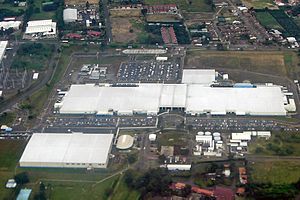
Intel's main office is in Santa Clara, California. The company has operations around the world. Its largest number of employees is in Washington County, Oregon, with 18,600 employees. Outside the United States, Intel has facilities in China, Costa Rica, Malaysia, Israel, Ireland, India, Russia, Argentina, and Vietnam. In March 2022, Intel stopped supplying the Russian market due to international sanctions during the Russo-Ukrainian War. In the U.S., Intel employs many people in California, Colorado, Massachusetts, Arizona, New Mexico, Oregon, Texas, Washington, and Utah. In Oregon, Intel is the state's largest private employer.
Intel invests a lot in research in China, with about 100 researchers in Beijing.
In 2011, the Israeli government offered Intel $290 million to expand in the country. This would create 1,500 more jobs in Kiryat Gat and between 600 and 1,000 jobs in the north.
In January 2014, it was reported that Intel would reduce about 5,000 jobs. In March 2014, Intel announced a $6 billion plan to expand its activities in Israel. This plan involves continued investment in existing and new Intel plants until 2030. As of 2014, Intel employed 10,000 workers in Israel.
Due to declining PC sales, Intel reduced 12,000 jobs in 2016. In 2021, under new CEO Pat Gelsinger, Intel started hiring thousands of engineers again.
Diversity at Intel
Intel has a Diversity Initiative, which includes groups for employees from different backgrounds, including race, nationality, sexual identity, and religion. In 1994, Intel supported one of the first corporate groups for Gay, Lesbian, Bisexual, and Transgender employees. They also support groups for Muslim, Jewish, and Christian employees.
Intel has received a 100% rating on many Corporate Equality Indices from the Human Rights Campaign. It is also often named one of the 100 Best Companies for Working Mothers by Working Mother magazine.
In January 2015, Intel announced it would invest $300 million over five years to improve gender and racial diversity within the company and the technology industry. In February 2016, Intel reported that its U.S. employees were 75.2% men and 24.8% women. For technical roles, it was 79.8% male and 20.1% female.
Economic Impact in Oregon
In 2011, a study found that in 2009, Intel's operations, spending, and taxes contributed almost $14.6 billion to Oregon's economy. This included $4.3 billion in personal income and 59,990 jobs. The study showed that for every 10 Intel jobs, about 31 jobs were created in other parts of the economy.
Supply Chain
Since the mid-1980s, Intel has worked to reduce the number of suppliers it uses. They follow an "n + 1" rule, meaning they figure out the maximum number of suppliers needed for each part and then use no more than one extra supplier.
Intel Israel
Intel has been working in Israel since Dov Frohman started the Israeli branch in 1974. Intel Israel now has development centers in Haifa, Jerusalem, and Petah Tikva. It also has a factory in Kiryat Gat that makes microprocessors and communication products. In 2013, Intel employed about 10,000 people in Israel. Maxine Fesberg was the CEO of Intel Israel from 2007 to 2016. Yaniv Gerti took over in January 2017.
In June 2024, the company announced it was stopping development on a factory in Kiryat Gat, Israel. This factory was expected to cost $25 billion, with $3.2 billion from the Israeli government.
Key Acquisitions and Investments (2010–Present)
In 2010, Intel bought McAfee, a company that makes computer security technology, for $7.68 billion. To get approval for this deal, Intel agreed to share information with rival security firms so their products could work with Intel's chips. After the purchase, Intel had about 90,000 employees, including 12,000 software engineers. In September 2016, Intel sold most of its McAfee business.
In August 2010, Intel bought Infineon's Wireless Solutions business. Intel planned to use this technology in laptops, smartphones, and tablets. In March 2011, Intel bought most of SySDSoft, a company based in Cairo. In July 2011, Intel agreed to buy Fulcrum Microsystems Inc., which specializes in network switches. In October 2011, Intel bought Telmap, an Israeli navigation software company.
In July 2012, Intel agreed to buy 10% of ASML Holding NV for $2.1 billion and another $1 billion for more shares. This deal was to help speed up the development of new chipmaking technologies.
In July 2013, Intel bought Omek Interactive, an Israeli company that makes technology for gesture-based interfaces. In September 2013, Intel acquired Indisys, a Spanish company that works on natural language recognition. In December 2014, Intel bought PasswordBox.
In January 2015, Intel bought a 30% share in Vuzix, a smart glasses maker. In February 2015, Intel agreed to buy Lantiq, a German network chipmaker. In June 2015, Intel announced it would buy FPGA design company Altera for $16.7 billion, its largest purchase at the time. This deal was completed in December 2015. In October 2015, Intel bought cognitive computing company Saffron Technology.
In August 2016, Intel bought deep-learning startup Nervana Systems. In December 2016, Intel acquired computer vision startup Movidius. In March 2017, Intel announced it would buy Mobileye, an Israeli company that develops "autonomous driving" systems, for $15.3 billion. In June 2017, Intel Corporation announced a large investment for its new Research and Development (R&D) center in Bangalore, India.
In January 2019, Intel announced an investment of over $11 billion for a new Israeli chip plant.
In November 2021, Intel hired some employees from the Centaur Technology division of VIA Technologies. In December 2021, Intel said it would invest $7.1 billion to build a new chip-packaging and testing factory in Malaysia. This new investment will expand its operations in Malaysia, creating over 4,000 new Intel jobs. In December 2021, Intel announced plans to make Mobileye a public company through an IPO in 2022, while keeping most of its ownership.
In February 2022, Intel agreed to buy Israeli chip manufacturer Tower Semiconductor for $5.4 billion. However, in August 2023, Intel ended the acquisition because it did not get approval from Chinese regulators. In May 2022, Intel announced it had acquired Siru Innovations, a Finnish graphics technology firm. In May 2022, Ericsson and Intel teamed up to launch a tech hub in California to focus on cloud RAN technology.
In April 2024, Intel agreed to sell 51% of Altera to Silver Lake. With this sale, Intel also canceled the planned IPO for Altera.
Ultrabook Fund (2011)
In 2011, Intel Capital announced a new fund to support new companies working on technologies for next-generation notebooks. Intel set aside $300 million to be spent over the next three to four years on areas related to ultrabooks. Intel introduced the ultrabook idea at Computex in 2011. An ultrabook is a thin notebook (less than 0.8 inches thick) that uses Intel processors and has tablet features like a touch screen and long battery life.
At the Intel Developers Forum in 2011, four Taiwan companies showed prototype ultrabooks using Intel's Ivy Bridge chips. Intel planned to make its chips for ultrabooks use less power.
Intel's goal for Ultrabook prices was below $1000. However, some company presidents said this goal would not be met if Intel did not lower the price of its chips.
Open Source Support
Intel has been very involved in open source communities since 1999. For example, in 2006, Intel released MIT-licensed X.org drivers for its graphics cards. Intel also released FreeBSD drivers for some networking cards.
However, after releasing its wireless products in 2005, Intel was criticized for not allowing free distribution of the firmware needed for these devices to work with open source operating systems. This led to campaigns asking Intel to change its policy. Some people claimed Intel was being "an Open Source fraud" because they did not want to upset their big customer, Microsoft. Despite the criticism, the binary firmware still does not have a license that fully supports free software principles.
Intel has also supported other open source projects like Blender and Open 3D Engine.
Intel's Brand Identity
Logo
Intel has had three distinct logos throughout its history.
The first Intel logo, from April 1969, was created by Robert Noyce and Gordon Moore. It showed the company's name in small letters using the Helvetica font in blue. The letter "e" was dropped below the other letters, connecting the T and L. This logo is known as the "dropped-e" logo.
The second logo, introduced on January 3, 2006, was created by FutureBrand. It combined parts of the old logo and the Intel Inside campaign, making it more modern. It removed the "dropped-e" and added a "vortex" made of two stripes. It also used a new font called Neo Sans Intel. This logo often featured Intel's new slogan, "Leap Ahead." In 2014, the font was changed to Intel Clear.
The third logo, introduced on September 2, 2020, was created by Andrew Mirikian Design using Intel One. It was inspired by the previous logos and aims to show that Intel is both traditional and reliable. It removes the swirl and redesigns the letters for a balanced look. The dot on the "I" is a new visual symbol, representing the power of their processors.
Intel Inside Campaign
Intel has become one of the most recognized computer brands because of its long-running Intel Inside campaign. The idea for "Intel Inside" came from a meeting between Intel and a computer reseller called MicroAge.
In the late 1980s, Intel was losing market share to cheaper competitors. In 1989, Intel's Dennis Carter met with Ron Mion from MicroAge. Intel wanted MicroAge to ask computer makers to use Intel chips. Mion suggested a market test: Intel would pay for a billboard saying, "If you're buying a personal computer, make sure it has Intel inside." MicroAge would put "Intel Inside" stickers on Intel-based computers in their stores. They did the test in Boulder, Colorado. Sales of Intel-based PCs quickly increased. Intel then made "Intel Inside" its main brand worldwide.
Intel's branding campaign started with "The Computer Inside" in 1990 in the U.S. and Europe. The Japan team suggested "Intel in it," which led to "Intel Inside" becoming a worldwide campaign in 1991. A case study about this campaign was created by Harvard Business School. The famous five-note jingle was introduced in 1994 and was heard in 130 countries by its tenth anniversary.
The Intel Inside advertising campaign aimed to build public loyalty and awareness of Intel processors. Intel paid some of the advertising costs for ads that used the Intel Inside logo and jingle.
In 2008, Intel planned to shift its "Intel Inside" campaign from TV and print to the Internet. Intel required that at least 35% of the money they gave to companies in their co-op program be used for online marketing. In 2014, the "Intel Inside" branding was updated to use the new Intel Clear font.
In April 2025, chief marketing officer Brett Hannath announced a new marketing campaign, "That's the power of Intel Inside," to show how Intel products are used in different markets and industries.
Intel Jingle
The D♭–D♭–G♭–D♭–A♭ xylophone/marimba jingle, known as the "Intel Spiral" or "Intel Bong," is used in Intel advertising. It was created by Walter Werzowa in 1994 for the launch of the Pentium. It was updated in 1999 for the Pentium III and again in 2004 for a new logo change. The melody remained the same.
Another version of the jingle came out with Intel's new visual identity in 2020. The company has used many different versions since then.
In 2017, the United States Copyright Office registered a copyright for the 1994 sound recording of the "Intel Spiral." However, they did not register the musical composition itself because it was considered too simple.
Processor Naming Strategy
In 2006, Intel started promoting open specification platforms beyond Centrino, including the Viiv media center PC and the business desktop Intel vPro.
In January 2006, Intel announced they were dropping the Pentium name from their processors. The Pentium name was first used for the P5 core processors because numbers like 486 cannot be legally trademarked. This prevented competitors from using the same name. They first removed the Pentium name from mobile processors when the new Yonah chips, called Core Solo and Core Duo, were released. Desktop processors changed when the Core 2 line came out. By 2009, Intel used a "good–better–best" strategy: Celeron was good, Pentium was better, and the Intel Core family was the best.
According to spokesman Bill Calder, Intel kept only the Celeron brand, the Atom brand for netbooks, and the vPro lineup for businesses. Since late 2009, Intel's main processors have been called Celeron, Pentium, Core i3, Core i5, Core i7, and Core i9, from lowest to highest performance. First-generation Core products have a 3-digit name (e.g., i5-750), and second-generation products have a 4-digit name (e.g., i5-2500). From the 10th generation onwards, Intel processors have a 5-digit name (e.g., i9-10900K for desktop). A 'K' at the end means it is an unlocked processor, allowing for more overclocking. vPro products are named Intel Core i7 vPro processor or Intel Core i5 vPro processor. In October 2011, Intel started selling its Core i7-2700K "Sandy Bridge" chip worldwide.
Since 2010, "Centrino" is only used for Intel's WiMAX and Wi-Fi technologies.
In 2022, Intel announced they would stop using the Pentium and Celeron names for their entry-level desktop and laptop processors. The "Intel Processor" brand will replace them starting in 2023.
In 2023, Intel announced they would remove the 'i' from their future processor names. For example, Core i7 will now be called Core 7. "Ultra" will be added to the names of higher-end processors, such as Core Ultra 7.
Typography
Neo Sans Intel is a special version of Neo Sans designed by Sebastian Lester in 2004. It was introduced with Intel's new brand in 2006. Before that, Intel used Helvetica as its standard font.
Intel Clear is a global font announced in 2014, designed for all communications. It was created by Red Peak Branding and Dalton Maag. It replaced Neo Sans Intel as the company's main font.
In 2020, as part of a new visual identity, a new font called Intel One was designed. It replaced Intel Clear for most of the company's branding, but Intel Clear is still used alongside it.
Intel Brand Book
The Intel Brand Book is a book created by Red Peak Branding as part of Intel's new brand identity campaign. It celebrates the company's achievements and sets new standards for how Intel looks, feels, and sounds.
Charity Work
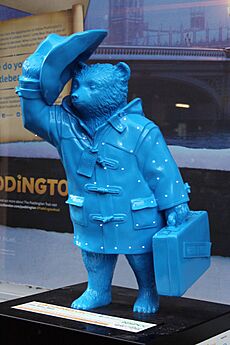
In November 2014, Intel designed a Paddington Bear statue called "Little Bear Blue." This was one of fifty statues created by celebrities and companies placed around London. The Intel-designed statue was outside Framestore, a British visual-effects company that uses Intel technology for films like Paddington. The statues were later auctioned to raise money for the National Society for the Prevention of Cruelty to Children (NSPCC).
Sponsorships
Intel sponsors the Intel Extreme Masters, a series of international esports tournaments. It also sponsored Formula 1 teams like BMW Sauber and Scuderia Ferrari. In 2013, Intel became a sponsor of FC Barcelona. In 2017, Intel became a sponsor of the Olympic Games, from the 2018 Winter Olympics to the 2024 Summer Olympics. In 2024, Intel and Riot Games had an annual sponsorship worth $5 million, and one with JD Gaming for $3.3 million. The company also sponsored Global Esports.
Product Challenges
Recalls
Pentium FDIV Bug
In June 1994, Intel engineers found a small issue in the math part of the P5 Pentium microprocessor. In very specific situations, the result of a floating-point division could be slightly wrong.
Security Vulnerabilities
Transient Execution CPU Vulnerability
In early January 2018, it was reported that almost all Intel processors made since 1995 had two security flaws called Meltdown and Spectre.
Instability Issues
Raptor Lake
In November 2024, some Intel customers who bought the company's Raptor Lake CPUs filed a lawsuit. They claimed that Intel knew about stability issues affecting 13th and 14th generation Raptor Lake CPUs but did not tell customers.
Images for kids
-
Headquarters in Santa Clara, California, in 2023
-
Andy Grove, Robert Noyce and Gordon Moore in 1978
-
Federico Faggin, designer of the Intel 4004
-
Intel microprocessor facility in Costa Rica was responsible in 2006 for 20% of Costa Rican exports and 4.9% of the country's GDP.
-
Paddington Bear statue in London designed by Intel, auctioned for the NSPCC
-
The since-2023 batches of the Intel Core 7 and the higher-end Intel Core Ultra 7 markings. They are direct successors to what has been known as the once-flagship Intel Core i7.
-
The since-2023 batches of the Intel Core 7 and the higher-end Intel Core Ultra 7 markings. They are direct successors to what has been known as the once-flagship Intel Core i7.
See also
 In Spanish: Intel para niños
In Spanish: Intel para niños


